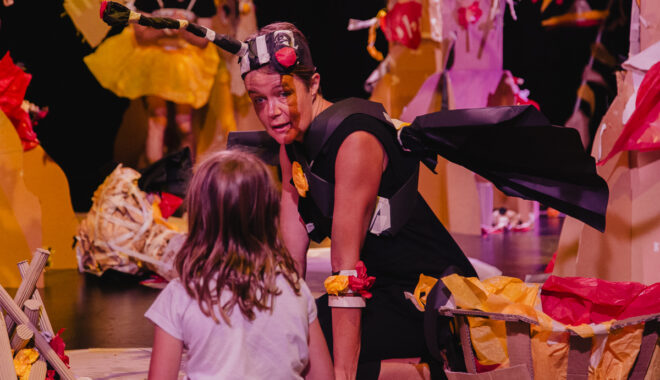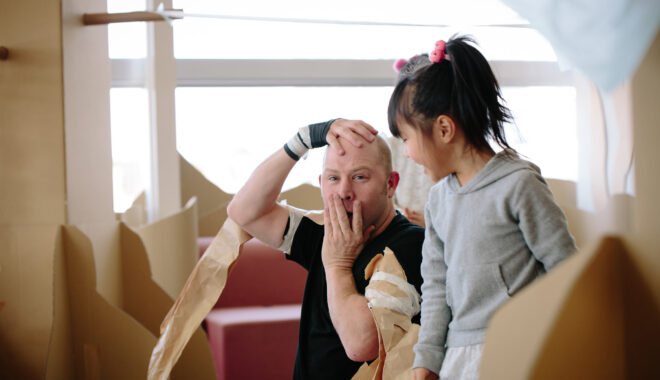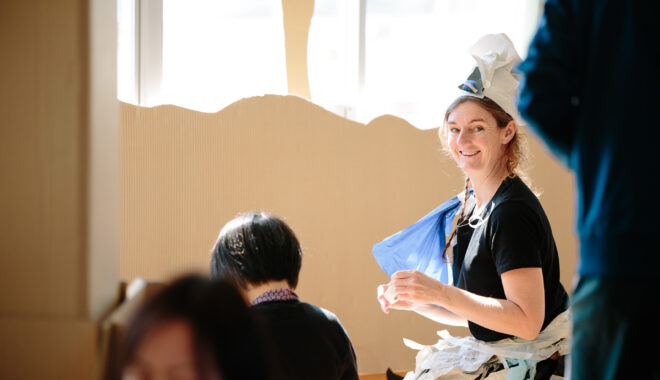11 Jul 2019 Artistic Reflections
“The kind of passion and dedication that is needed when you make your work together”
In April, Polyglot’s Artistic Director Sue Giles, attended the ASSITEJ International Executive Committee meeting in Uruguay, in her capacity as Vice President. ASSITEJ International is the
global association of theatre for young audiences. Sue kept a travel diary of the experience – we’re pleased to share some excerpts with you below.
Day 2 – Sunday April 25
The ASSITEJ International Executive Committee work has increased dramatically since I joined and everyone is feeling it. We have a few observers this time too – following up on the Open Executive Committee idea of inviting people to join and see how the work is done and also to introduce potential members to the inside workings. Yvette and Louis are alike in their desire to be as transparent as possible so this week’s work will be around creating conflict of interest procedures, expanding on the National Centre tool kit and also discussing Gatekeeping in the association. We also have Mr Shimoyama and Ms Minamoto from Tokyo congress and also Mr Yin and Su Su from ASSITEJ China, Gonzales – a delegate from Spain, the Ibro American Network members and Yannick from Belgium. All sorts of personalities plus our usual crazy mix of languages and types.
Day 3 – Monday April 29
All the ASSITEJ Uruguay Festival shows were in the classically beautiful Teatro Solis, built in 1856, from plans drawn up by an Italian architect that was dismissed halfway through the project because he was discovered to have been of an opposing political faction. The work was completed by a Uruguayan (who followed the first one’s plans).
The children were all from public schools. The festival has been trying to get more involvement from the public schools and has succeeded very well at this fifth Festival, with full houses for most of the works.
Back to the Teatro Solis again after lunch and this time Cantana de Pedro y la Guerra. A play written by Marie Inez from Argentina and co-directed by our own Daniel and another Uruguayan director Gabriel. This was set in traverse, and for an older audience. The public school children all wear white overalls over their clothes, with large blue silk floppy bows, like painters’ smocks. The show was good – well-crafted and with an excellent performance ensemble, in the mode of performance that is very recognisable, direct address and live song and music underlying the action, swift changes of character and use of props and space minimal and clean, relying on performance to relay the story. Design elements of wood and clothing beige and brown. The play was about the impact of war on children whether they are involved or not, and it left some of the kids in tears.
We went outside into the sunshine and I had a meeting with Kenjiro about the Australian showcase idea which went down very well. He will talk to Mr Shiomoyama about it. We need to think of a process to offer the idea to the Australian artists going to the festival.
We walked back to the hotel for our Executive Committee meeting where we heard about the work done on the Creative Europe application. Here in Uruguay we were trying to garner support from associated festivals in the Ibro American network to host some of the work of the project.
At 7 we all met for a city tour in a bus which took us around and about the interest point of the city – the Municipality buildings, the parliament, the significant fountains, the obelisk, the circular theatre, the Ramblas, the city park that used to be the president’s private garden, and the beach front.
Dinner was at a charming restaurant/bar and theatre venue run by the director of the show that opened the ASSITEJ Uruguay festival and who told us how things run for performers of children’s theatre here in Montevideo. There are about 50 companies, all working part time on jobs to support their involvement. Very little funding is available, and there are only three critics of children’s theatre in the city. Grants that in total offer only $8,000 each year that must pay for two plays, so basically no one gets paid properly ever. In their winter festival there are over 100 shows across five days, many of which are ‘non-professional’. The theatre companies act more as families. His company for instance, employs the performers in the theatre and cafe – behind the bar, as cooks, etc and focuses on the training and professional development of his ensemble, so that young performers will gradually become expert enough to begin training up newer members and take on directing roles, writing roles etc. For him it is all about pathways for the young ones.
Day 4 – Tuesday April 30
We saw another show first thing the next day, El Illustrator. Busloads of kids in their white smocks gathering at the Teatre Solis, and greeted by the clowns who are part of the festival tradition, the South American children’s theatre tradition apparently. The clowns were there to greet the children before every show, take them into the theatre, do funny stuff with them before the show on the stage, and then see them out and onto their buses. The group doing this work were very good at their job and completely in character from beginning to end, even with us all. I don’t know that I like the tradition though – it seems to create the same expectation in the audience for every work – exciting the children into laughter, doing call and response, look behind you, etc. which certainly doesn’t suit every work
This show, El Illustrator, was in the big theatre. An absolutely gorgeous La Scala type theatre with walls of theatre boxes going to the frescoed and chandeliered ceiling, seats in red velvet and gilded columns and red velvet curtains with gold tassels and fringes. It was full of white-smocked children (who screamed every time the lights went out).
The final show in the festival was Lobos Estas, a work created by a company of young people in a town in the north of Uruguay and their community came with them to see it. The young cast were obviously thrilled to be on the stage in front of the huge auditorium with all those children (who screamed at every black-out and yelled, ‘there’s a wolf’, every time a wolf appeared on stage, smothering the dialogue with their yells). At the end the parents of the cast were waving the flag for the town and a big banner they unfurled and shook about – very funny and very sweet. In the end, the festival was a combination of professional works and works created for performance by young school-aged actors.
Day 5 – Wednesday May 1
Our Executive Committee meeting was all day, starting with the China report, then a presentation from the Japanese team on the Mirai Festival. Mirai means ‘Future’ in Japanese. They have created a strong statement about the festival, the statement starts:
“There has not been anytime that the power of culture is as significant as it is now. All the movements of people, things and information have speeded up, and our societies are changing rapidly. Biotechnology and artificial intelligence have now thrown up the fundamental question, “What is Human?”
It ends with this sentence:
“We all know we can no longer build an affluent society by economy alone. Since ancient times we have explored the essence of humanity, mapped our future, accumulated and inherited culture and wisdom through the arts. The encounter for children with culture is our very future.”
Their vision for the festival and the congress is about inclusion (“no one is left behind”), dignity and respect, courage and confrontation, protection and cultivation.
It was very moving to hear them both and it is an ambitious reach they are planning – including establishing a nationwide platform for engagement – connecting with 1000 regions across Japan.
Day 7 – Friday May 3
The last day of meetings. This morning started with the Ibero American network and there were a few interesting suggestions that might help with some of the barriers to healthy membership. The younger members, particularly an excellent artist from Cuba, wanted to be more active and big picture and ambitious about everything. It has been a theme in this visit that there are those in the organisation who are nay-sayers, consistently negative and unable to imagine different ways of doing things, and those who are impatient with this but are struggling against years of domination and cultural respect for hierarchy.
After the group discussion we split into smaller groups to find out in more detail how people managed their activities and what everyone’s context was. This was really interesting (at least for our group – we had Cuba, Uruguay, Argentina and Norway and me). Then back together and a big photo outside with all of us from several phones (photos take AGES!).
Yvette and I strode in our very speedy fashion back to the hotel for lunch, then back to the meeting we went – the last hurrah for the working groups. We’ve decided to fast-track a few of the items – the National Centre Toolkit and the Advocacy messaging – so it can be used to help shake up some of the gatekeeping issues we’re facing. There are more and more examples coming forward from individuals who can’t seem to join or don’t want to join their National Centre for some reason. Lots of work to do before Kristiansand.
Then we were picked up to meet the Director of the Ministry of Culture and the Director of the Art museum and to see the Picasso exhibition. This was a lovely interlude, the sun streaming into the big airy space, the interesting contemporary Uruguayan arts works, lots of laughter and chat amongst us all and little knots of conversation. The Director of the Ministry of Culture was a very energetic youngish man who is about to finish his term with Government and go back to being an artist. He discovered that I was an Australian and then said his teacher, when he was studying performance in Berlin, was an Australian. I asked who it was and he said David Pledger! So of course I said I knew him and we chatted away merrily until we had to leave.
Day 9 – Sunday May 5
Daniel had arranged for us to see a dress rehearsal of a play that one of his friends has directed at 2pm. The rehearsal was in a house – the front room of which was turned into a theatre, by the owner and theatre director Gabriel. It used to be a grocery shop owned by Gabriel’s grandfather.
We perched on a steep little hand-built rake of shelves next to the tech desk (the theatre holds 20) and wondered what would happen next. WELL! It was amazing. Hilarious, absurd, dangerous, beautifully acted and directed – no idea what it was about but set in an office with some fascinating characters and obviously a lot going on. We loved it. Ended with a wild rock and roll number, with everyone ripping their shirts off and whirling their hair around. Huge emotion afterwards from the cast – all hugging and crying and talking at once. We hugged them all too and said goodbye and left them to their notes or however they do it. What an experience.
It was such a good reminder of the kind of passion and dedication that is needed when you make your work together, as a student or as an artist starting out, or as an independent anywhere. We all do this, all over the world. The circumstances change for many especially where there is funding, so this kind of expertise and commitment is never long lasting in Australia. Those independent theatre companies that have come and gone, what happens to those people? These were all experienced professionals, none of whom were paid for their time, none of whom are ever paid for their time, unless they get a role in one of the state theatre ensembles. Rehearsals have to happen over six months minimum because they all have to work. This rehearsal is the last one before opening in a week. They will continue to do work in this way because they have no other way of doing it. (Funding for theatre is available but the maximum you can receive is $12,000. Out of 100 applications, six may get the funding. For children’s theatre there is $8,000 allocated a year for two plays.)
We walked home in the rising mist, which put a fairy tale screen across everything we passed: the old grey buildings disappearing into the middle distance, the conquering hero on his massive steed facing a mystical building like a fantasy castle, a yellow-lit tent filled with old men chatting and smoking, the palms incongruous in the plaza, the gateway to the new town like a portal that ends our trip. At 6.30 we were picked up and went to the airport. Adios Montevideo and Uruguay.







